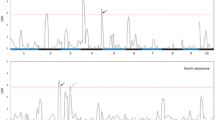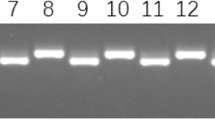Abstract
In hybrid breeding the performance of lines in hybrid combinations is more important than their performance per se. Little information is available on the correlation between individual line and testcross (TC) performances for the resistance to European corn borer (ECB, Ostrinia nubilalis Hb.) in maize (Zea mays L.). Marker assisted selection (MAS) will be successful only if quantitative trait loci (QTL) found in F2 derived lines for ECB resistance are still expressed in hybrid combinations. The objectives of our study were: (1) to identify and characterize QTL for ECB resistance as well as agronomic and forage quality traits in a population of testcrossed F2:3 families; (2) to evaluate the consistency of QTL for per se and TC performances; and (3) to determine the association between per se and TC performances of F2:3 lines for these traits. Two hundred and four F2:3 lines were derived from the cross between maize lines D06 (resistant) and D408 (susceptible). These lines were crossed to D171 and the TC progenies were evaluated for ECB resistance and agronomic performance in two locations in 2000 and 2001. Using these TC progenies, six QTL for stalk damage rating (SDR) were found. These QTL explained 27.4% of the genotypic variance in a simultaneous fit. Three QTL for SDR were detected consistently for per se and TC performance. Phenotypic and genotypic correlations were low for per se and TC performance for SDR. Correlations between SDR and quality traits were not significant. Based on these results, we conclude that MAS will not be an efficient method for improving SDR. However, new molecular tools might provide the opportunity to use QTL data as a first step to identify genes involved in ECB resistance. Efficient MAS procedures might then be based on markers designed to trace and to combine specific genes and their alleles in elite maize breeding germplasm.
Similar content being viewed by others
References
Beavis B (1994) The power and deceit of QTL experiments. American Seed Trade Association meeting, Chicago, 1994
Bergvinson DJ, Arnason JT, Mihm JA, Jewell DC (1996) Phytochemical basis for multiple borer resistance in maize. In: Insect resistant maize: recent advances and utilization. Proceedings of the international symposium of the CIMMYT, Mexico, 1996
Bohn M, Khairallah MM, Gonzales-de-Leon D, Hoisington DA, Utz HF, Deutsch JA, Jewell DC, Mihm JA, Melchinger AE (1996) QTL mapping in tropical maize. I. genomic regions affecting leaf feeding resistance to sugarcane borer and other traits. Crop Sci 36:1352–1361
Bohn M, Schulz B, Kreps R, Klein D, Melchinger AE (2000) QTL mapping for resistance against the European corn borer (Ostrinia nubilalis H.) in early maturing European dent germplasm. Theor Appl Genet 101:907–917
Bohn M, Groh S, Khariallah MM, Hoisington DA, Utz HF, Melchinger AE (2001) Re-evaluation of the prospects of marker-assisted selection for improving insect resistance to Diatraea spp. in tropical maize by cross validation and independent validation. Theor Appl Genet 103:1059–1067
Buckler E, Thornsberry JM (2002) Plant molecular diversity and application to genomics. Curr Opin Plant Biol 5:107–111
Buendgen MR, Coors JG, Grombacher AW, Russel AW (1990) European corn borer resistance and cell wall composition of three maize populations. Crop Sci 30:505–510
De Boever JL, Cottyn BG, Wainman FW, Vanacker JM (1986) The use of an enzymatic technique to predict digestibility, metabolizability and net energy of compound feedstuffs for ruminants. Anim Feed Sci Technol 14:203–214
Dolstra O, Medema JH (1990) An effective screening method for improvement of cell-wall digestibility in forage maize. In: Hinterholzer J (ed) Proceedings of the 15th Eucarpia congress maize-sorghum, Baden, Austria, 4–8 June 1990, pp 258–270
Duffey SS, Felton GW (1991) Enzymatic antinutritive defenses of tomato plants against insects. In: PA Hedin (ed) Naturally occurring pest regulators. American Chemical Society symposia series 449, Washington, D.C., pp 167–197
Felton GW, Donato KK, Del Vecchio RJ, Duffey SS (1989) Activation of plant foliar oxidases by insect feeding reduces nutritional quality of dietary protein to a noctuid herbivore. J Insect Physiol 38:277–285
Flint-Garcia SA, Darrah LL, McMullen MD, Hibbard BE (2003) Phenotypic versus marker-assisted selection for stalk strength and second-generation European corn borer resistance in maize. Theor Appl Genet (in press)
Gardiner JM, Coe EH, Melia-Hancock S, Hoisington DA, Chao S (1993) Development of a core RFLP map in using an immortalized F(2) population. Genetics 134:917–930
Goffinet B, Gerber S (2000) Quantitative trait loci: a meta-analysis. Genetics 155:463–473
Groh S, Khairallah MM, Gonzáles-de-Léon D, Willcox M, Jiang C, Hoisington DA, Melchinger AE (1998) Comparison of QTLs mapped in RILs and their test-cross progenies of tropical maize for insect resistance and agronomic traits. Plant Breed 117:193–202
Haldane JBS (1919) The combination of linkage values, and the calculation of distance between the loci of linked factors. J Genet 8:299–309
Haley CS, Knott SA (1992) A simple regression method for mapping quantitative trait loci in line crosses using flanking markers. Heredity 69:315–324
Hallauer AR (1990) Methods used in developing maize inbreds. Maydica 35:1–16
Hudon M, Chiang MS (1991) Evaluation of resistance of maize germplasm to the univoltine European corn borer Ostrinia nubilalis (Hübner) and relationship with maize maturity in Quebec. Maydica 36:69–70
Jampatong C, McMullen MD, Barry BD, Darrah LL, Byrne PF, Kross H (2002) Quantitative trait loci for first- and second-generation European corn borer resistance derived from the maize inbred Mo47. Crop Sci 42:584493
Johnson K, Felton GW (2001) Plant phenolics as dietary antioxidants for herbivorous insects: a test with genetically modified tobacco. J Chem Ecol 27:2579–2597
Keightley PD, Knott SA (1999) Testing the correspondence between map positions of quantitative trait loci. Genet Res Camb 74:323–328
Khairallah M, Bohn M, Jiang CZ, Deutsch JA, Jewell DC, Mihm JA, Melchinger AE, Gonzáles-de-Léon D, Hoisington D (1998) Molecular mapping of QTL for southwestern corn borer resistance, plant height, and flowering in tropical maize. Plant Breed 117:309–318
Kjeldhal J (1883) Neue Methode zur Bestimmung des Stickstoffs in organischen Körpern. Z Anal Chem 22:366–382
Knapp SJ, Stroup WW, Ross WM (1985) Exact confidence intervals for heritability on a progeny mean basis. Crop Sci 25:192–194
Krakowsky MD, Brinkmann MJ, Woodman-Clikeman WL, Lee M (2002) Genetic components of resistance to stalk tunneling by European corn borer in maize. Crop Sci 42:1309–1315
Kreps RC, Gumber RK, Schulz B, Klein D, Melchinger AE (1998) Genetic variation in testcrosses of European maize inbreds for resistance to the European corn borer and relations to line per se performance. Plant Breed 117:319–327
Lande R, Thompson R (1990) Efficiency of marker-assisted selection in the improvement of quantitative traits. Genetics 124:743–756
Lander ES, Green P, Abrahamson J, Barlow A, Daly MJ, Lincoln SE, Newburg L (1987) MAPMAKER: an interactive computer package for constructing primary genetic linkage maps of experimental and natural populations. Genomics 1:174–181
Lee, M (1993) Genetic analysis of resistance to European corn borer and northern corn leaf blight in maize. In: Wilkinson D (ed) Proceedings of the 48th Annual Corn and Sorghum Industry Research Conference, Washington, D.C., pp 213–223
Luff G, Schoorl W (1929) Chem Weekbl 26:130
Magg T, Melchinger AE, Klein D, Bohn M (2001) Comparison of Bt maize hybrids with their non-transgenic counterparts and commercial varieties for resistance to European corn borer and for agronomic traits. Plant Breed 120:397–403
McMullen MD, PF Byrne, ME Snook, BR Wiseman, EA Lee, NW Widstrom (1998) Quantitative trait loci and metabolic pathways. Proc Natl Acad Sci USA 95:1996–2000
Melchinger AE, Utz HF, Schön CC (1998) Quantitative trait locus (QTL) mapping using different testers and independent population samples in maize reveals low power of QTL detection and large bias in estimates of QTL effects. Genetics 149:383–403
Mihm JA (1983) Efficient mass rearing and infestation techniques to screen for host plant resistance to maize stem borers, Diatratea spp. CIMMYT, Mexico
Mode CJ, Robinson HF (1959) Pleiotropism and genetic variance and covariance. Biometrics 15:518–537
Naumann C, Bassler R (1998) Die chemische Untersuchung von Futtermitteln. Loseblatt-Ausgabe, Handbuch der landwirtschaftlichen Versuchs- und Untersuchtungsmethodik 3. VDLUFA-Verlag, Darmstadt
Onukogu FA, Guthrie WD, Russell WA, Reed GL, Robbins JC (1978) Location of genes that condition resistance in maize to sheath-collar feeding by second-generation European corn borer. J Econ Entomol 71:1–4
Papst C, Melchinger AE, Eder J, Schulz B, Klein D, Bohn M (2001) QTL mapping for resistance to European corn borer (Ostrinia nubilalis Hb.) in early maturing European dent maize (Zea mays L.) germplasm and comparison of genomic regions for resistance across two populations of F3 families. Maydica 46:195–205
SAS Institute (1996) SAS users guide. SAS Institute, Cary, NC
Schön CC, Lee M, Melchinger AE, Guthrie WD, Woodman WL (1993) Mapping and characterizing of quantitative trait loci affecting resistance against second generation European corn borer in maize with the aid of RFLPs. Heredity 70:648–659
Schulz B, Kreps R, Klein D, Gumber RK, Melchinger AE (1997) Genetic variation among European maize inbreds for resistance to the European corn borer and relation to agronomic traits. Plant Breed 116:415–422
Searle SR (1971) Linear models. Wiley, New York
Stuber CW (1995) Mapping and manipulating quantitative traits in maize. Trends Genet 11:477–481
Thome CR, Smith ME, Mihm JA (1992) Leaf feeding resistance to multiple insect species in a maize diallel. Crop Sci 32:1460–1463
Tilley JMA, Terry RA (1963) A two stage technique for the in vitro digestion of forage crops. J Br Grassl Soc 18:104–111
Utz HF (2001) PLABSTAT v2P. A computer program for statistical analyses of plant breeding experiments. Institute of Plant Breeding, Seed Science and Population Genetics, University of Hohenheim, Stuttgart
Utz HF (2002) CORRESP. A computer program to test for the correspondence between QTL positions of two experiments. Institute of Plant Breeding, Seed Science and Population Genetics, University of Hohenheim, Stuttgart
Utz HF, Melchinger AE (1996) PLABQTL. A computer program to map QTL. J QuantTrait Loci 2:1
Utz HF, Melchinger AE, Schön CC (2000) Bias and sampling error of the estimated proportion of genotypic variance explained by quantitative trait loci determined from experimental data in maize using cross validation and validation with independent samples. Genetics 154:1839–1849
Acknowledgements
This research was supported by grants from the Bavarian State Ministry for Agriculture and Forestry. We are grateful to K. Fickler and S. Götze for technical assistance with field trials. The authors gratefully acknowledge the skilled technical assistance of E. Kokai-Kota for the excellent laboratory work. The support of KWS SAAT AG, Germany, for NIRS calibration of forage quality traits is greatly appreciated.
Author information
Authors and Affiliations
Corresponding author
Additional information
Communicated by G. Wenzel
Rights and permissions
About this article
Cite this article
Papst, C., Bohn, M., Utz, H.F. et al. QTL mapping for European corn borer resistance (Ostrinia nubilalis Hb.), agronomic and forage quality traits of testcross progenies in early-maturing European maize (Zea mays L.) germplasm. Theor Appl Genet 108, 1545–1554 (2004). https://doi.org/10.1007/s00122-003-1579-3
Received:
Accepted:
Published:
Issue Date:
DOI: https://doi.org/10.1007/s00122-003-1579-3




